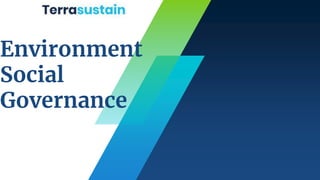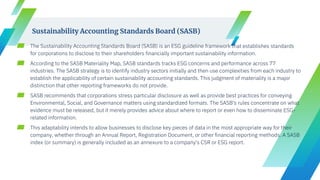ESG
- 2. ▰ The abbreviation ESG stands for Environmental, Social, and Governance. ▰ ESG embraces the broad view that sustainability encompasses more than simply environmental concerns. ▰ ESG may be defined as a framework that assists stakeholders in understanding how a business manages risks and opportunities connected to environmental, social, and governance criteria. Even though the word "ESG" is frequently used in relation to investing, stakeholders also include businesses such as suppliers, workers, and consumers. They're all becoming more and more curious in how sustainably an organization operates. ▰ An organization's management of risks and opportunities related to sustainability concerns can be better understood by stakeholders by using the ESG framework. Earlier the historical initiatives that concentrated on health and safety problems, pollution control, and corporate charity have influenced ESG. Several financial and asset allocation choices are now influenced by ESG. What is ESG?
- 3. ▰ E stands for Environmental ▰ Environmental criteria are the impacts and management policies of a company caused effects to environment. All of them includes direct and indirect greenhouse gas emissions, natural resource management, and the company’s vulnerability to real climate threats (like climate change, flooding, and fires). ▰ S stands for Social ▰ The ties between a company and its stakeholders are referred to as the social pillar. An organization's influence on the communities in which it works and on supply chain partners, particularly those in developing nations where environmental and labour regulations may be less stringent, are further examples of issues that a corporation may be judged against. ▰ G stands for Governance ▰ Governance is concerned with how a business is managed and controlled. ESG analysts always aims to get a better understanding of how leader's incentives are matched to stakeholders' expectation, how shareholder rights are seen, and what kinds of internal controls are in place to encourage leadership transparency and accountability. Overview of E, S & G
- 4. ▰ ESG concerns include a wide range of themes that are relevant to all businesses and organizations in some manner. ESG investment encompasses a larger range of concerns, such as: ▰ Environmental- Climate change, Greenhouse gas (GHG) emissions, resource depletion, waste and pollution, Water and energy efficiency, Deforestation, Biodiversity ▰ Social- Working conditions, Equal opportunities, Human rights, Employee diversity, Health and safety, Child labor and slavery, Community engagement, Philanthropy ▰ Governance- Business ethics, Executive pay, Board diversity and structure, Bribery and corruption, Political lobbying and donations, Tax strategy, Compliance What are the subjects covered by ESG, and how are they rated?
- 5. ▰ Investment that promotes the best environmental, social, and governance (ESG) elements or outcomes is referred to as ESG investment. ▰ ESG investing is frequently viewed as a strategy to invest "sustainably"—where investments are made taking into account the environment, human welfare, and the economy. ▰ It is built on the rising belief that environmental and social concerns are having an increasing impact on the financial performance of enterprises. ▰ When a company does not adhere to certain environmental, social, or corporate governance requirements, ESG investors will not purchase its shares. ▰ For instance, commercial companies that extensively pollute the environment or businesses with immoral labor practices. ESG investing has gradually gained attention around the world, with several investment funds employing this concept recently. What is ESG Investing?
- 6. ▰ ESG is Good for People and Earth ╺ There's a common misconception that ethics and finance don't mix. People used to believe that ESG investment would result in worse results. But the statistics reveal that it is not the true scenario. ESG investment produces returns that are comparable to or even above those of standard funds, according to research from recent years. ▰ ESG is Interconnected to tremendous growth ╺ Businesses with strong ESG offers may empower them not only to develop into key markets but also access to new ones. By providing more environmentally friendly goods, businesses may draw in both B2B (Business-to-Business) and B2C (Business-to-Consumer) customers with the aid of an effective ESG approach. By fostering closer ties between the government and the community, it gives companies better access to various resources. ESG may also influence customer preferences. ▰ ESG offers good quality returns ╺ By providing funding to more sustainable and viable options, such as absorbents, renewable sources, and waste minimization, a strong ESG offer may generate significant investment returns. ESG may also assist organizations in avoiding stranded investments that may fail to pay off owing to long-term environmental issues, such as a significant drop in the value of tanker trucks. ▰ ESG Funds reduce the risk ╺ ESG equities not only function well over time but also reduce risk options for investors, which is a key factor in the importance of ESG investing. A customer or investor will be making a less hazardous investment if they can recognize a legitimate ESG company. ESG-focused companies tend to become less unpredictable and have better reputations because they are devoted to conforming to state regulations and implementing a fair ESG framework. Why is investing important?
- 7. ▰ ESG frameworks are strategies for standardizing ESG metric reporting and disclosure. ▰ They are frequently optional, although in some places, they may be compelled by a specific investor or by legislation. ▰ Non-profit organizations, NGOs, corporate groupings, and others create these frameworks. As a result, their areas of attention and the measures they prescribe differ greatly. ESG Framework
- 8. ▰ ESG frameworks assist businesses in having a good influence on society. It has also been demonstrated that reporting on ESG provides additional advantages for the organization. As an example: ╺ Strong ESG policies can help companies reduce energy, water, and waste costs and drive more strategic resource allocation. ╺ Consumers are putting more and more pressure on businesses to be socially and environmentally responsible. ╺ Investors are increasingly considering ESG as a standard aspect of the investment process. ╺ Employees are also invested in corporate responsibility, so ESG reporting can contribute to employee morale/productivity and help attract talent. Why are ESG frameworks important?
- 9. ▰ Carbon Disclosure Project (CDP) ▰ Climate Disclosure Standards Board (CDSB) ▰ Global Reporting Initiative (GRI) ▰ Science-Based Targets initiative (SBTi) ▰ Sustainability Accounting Standards Board (SASB) ▰ Task Force on Climate-Related Financial Disclosures (TCFD) ▰ United Nations- Principles for Responsible Investment (UN PRI) Different types of sustainability reporting?
- 10. ▰ CDP is a non-profit aid organization that runs the disclosure system for global investors, companies, and provinces to control their environmental impacts. ▰ Every year CDP helps many companies to assess and control their risks and opportunities on climate change, water security, and desertification. ▰ The collection of self-reported data from the companies is supported by over 800 institutional investors with about US$100 trillion in assets. ▰ Nearly a fifth of global greenhouse gas emissions is reported through CDP. ▰ This information helps investors, corporations, and regulators to measure and understand the environmental impact of their decisions and take steps to address and limit their risk to climate change, deforestation, and water security. ▰ How do companies report through CDP? ▰ Companies disclose their information through CDP’s three corporate surveys on climate change, water security, and forests. ▰ This benefits companies to deliver information on social and environmental factors to their investors, customers, and other stakeholders, involving governance and policy, and opportunity management, goals, and strategies. Investors and customers can ask for environmental data from companies via CDP, and the data is used by these stakeholders to inform decisions and drive action. Carbon Disclosure Project (CDP)
- 11. ▰ The CDSB creates a climate change reporting framework (the "CDSB Framework"). ▰ The framework is presently being extended to include these forms of environmental things related to climate change, for instance, information concerning water and forest risk commodities. ▰ The framework was originally focused on risks and opportunities that climate change brings to an organization's strategy, financial performance, and condition. Climate Disclosure Standards Board (CDSB)
- 12. ▰ The Global Reporting Initiative (GRI) is a network-based multinational non-profit organization. ▰ The GRI creates free Sustainability Reporting Guidelines to make it possible for all businesses and organizations to report on their performance in the areas of economic, environmental, social, and governance. Reportedly, the standards are in their fourth generation ("G4"). Global Reporting Initiative (GRI)
- 13. ▰ Science-based targets put businesses on a realistic path towards decarbonization by demonstrating to stakeholders how often or rapidly they must cut their GHG emissions to avert the worse effects of climate change. ▰ SBTi helps businesses fight climate change while reaping the advantages and increasing their profitability in the transformation to a net-zero economy by helping them in the science-based objective formulation. Science-Based Targets initiative (SBTi)
- 14. ▰ The Sustainability Accounting Standards Board (SASB) is an ESG guideline framework that establishes standards for corporations to disclose to their shareholders financially important sustainability information. ▰ According to the SASB Materiality Map, SASB standards tracks ESG concerns and performance across 77 industries. The SASB strategy is to identify industry sectors initially and then use complexities from each industry to establish the applicability of certain sustainability accounting standards. This judgment of materiality is a major distinction that other reporting frameworks do not provide. ▰ SASB recommends that corporations stress particular disclosure as well as provide best practices for conveying Environmental, Social, and Governance matters using standardized formats. The SASB's rules concentrate on what evidence must be released, but it merely provides advice about where to report or even how to disseminate ESG- related information. ▰ This adaptability intends to allow businesses to disclose key pieces of data in the most appropriate way for their company, whether through an Annual Report, Registration Document, or other financial reporting methods. A SASB index (or summary) is generally included as an annexure to a company's CSR or ESG report. Sustainability Accounting Standards Board (SASB)
- 15. ▰ It was created by the Financial Stability Board (FSB) in recognition that climate change presents a significant risk to the global financial sector, which they have estimated at USD$5 trillion in potential losses. ▰ It is a guidance framework that helps companies disclose climate-related financial risks to investors, lenders, and insurers. TCFD recommendations are focused on governance, strategy, risk management, and metrics and targets. ▰ TCFD is made up of 11 Recommended Disclosures divided into four pillars. ╺ Governance ╺ Strategy ╺ Risk Management ╺ Metrics & Targets Task Force on Climate-Related Financial Disclosures (TCFD)
- 16. ▰ The UN Principles for Responsible Investment (PRI) is an international organization that works to encourage the incorporation of ESG factors in investment decision-making. ▰ It was launched in April 2006 and was supported by United Nations (UN). Currently, ▰ PRI has over 2,700 active financial institutions, as of August 2021. These institutions take part by becoming participants in the six key principles and then recording normal statements on their growth. ▰ The primary idea behind the organization is that environmental and social factors are important elements in investment decision-making and should be considered by responsible investors. ▰ As expressed on the organization’s website, these six principles are as follows: ╺ Principle 1: We will incorporate ESG issues into investment analysis and decision-making processes. ╺ Principle 2: We will be active owners and incorporate ESG issues into our ownership policies and practices. ╺ Principle 3: We will seek appropriate disclosure on ESG issues by the entities in which we invest. ╺ Principle 4: We will promote acceptance and implementation of the principles within the investment industry. ╺ Principle 5: We will work together to enhance our effectiveness in implementing the principles. ╺ Principle 6: We will each report on our activities and progress towards implementing the principles. United Nations- Principles for Responsible Investment (UN PRI)
- 17. Thank You Contact Us- hello@terrasustain.com

















